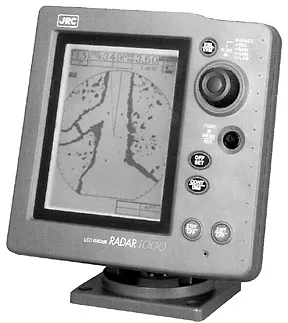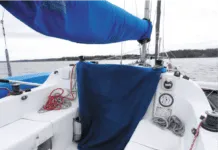The subject of radar reflectors around yacht club bars is usually dominated by an almost infinite variety of anecdotal tales, most of which have little or no bearing on whether you, in a small boat, will be seen by a large ship at sea. One of the many questions related to being seen by another radar is, “How large is my boat’s radar cross section (RCS), with and without a radar reflector?”

This is a very difficult question to answer, and, of course, would be different for every individual boat. Because X-band radar wavelengths are just a little over an inch long, and a typical sailboat is hundreds or thousands of inches long, the sailboat’s RCS pattern might resemble the quills on the back of a porcupine, i.e., a vast number of narrow interference lobes caused by scattering from a variety of objects such as winches, blocks, stoves, even people. Some of the lobes might be very intense but extremely narrow, such as the specular or mirror-like reflection from a straight mast or flat metal surface, but most would be randomly sized and spaced.
Some comprehensive measurements addressing the practical implications of this were published in the UK publication, Yachting Monthly (October 1995), describing the findings of Professor Graham King, head of Systems Engineering Research at the Southampton Institute. These findings were summarized in an editorial reply to a letter to Practical Sailor, June 1, 1996, pgs. 3-4. One of Professor King’s conclusions was that “within a two-mile range, most vessels over 20 feet are likely to be just as visible without a reflector as with one. However, that level of visibility might in itself be so marginal, especially in poor weather and sea conditions, as to be of little use for collision avoidance between small craft and commercial shipping.”
Another result of these trials was that, “at a range of one mile a man in a stable 4.8m rigid inflatable without a reflector would actually give around 2.5 square meter (sm) reflection in good weather, with a further 1.5 sm coming from a small outboard when fitted—a total figure similar to the average results recorded from most small craft reflectors on the level.”
And finally, to quote Prof. King directly, “It would be quite reasonable in cases of rundown for a manual radar watch keeper to claim target invisibility in real-world sea conditions.”
It is clear from the above observations, plus the carefully measured data from a variety of commercially available radar reflectors, that even the best of them could provide only a marginal improvement in the RCS that already exists from the average sailboat.
Are they worth it? This depends on how you want to weigh the various tradeoffs, such as cost, weight and windage aloft, chafe, ease of storage, and so on.
Ultimately, we suspect that future solutions may involve the use of an active Radar Target Enhancer (RTE) that will return a much greater signal to a radar than any reasonably sized passive reflector could ever do, yet do so with minimal average power consumption and, by clever design, with minimal interference among multiple radar systems. We know of two RTEs that are in use today, the Ocean Sentry from Pains Wessex and the ActivEcho from Serpe-Iesm. There is also an entirely different product called a Search and Rescue Transponder (SART) which transmits a RACON-like 12-pulse radar distress signal. SARTs must not be used to routinely enhance radar visibility.
Eventually, GPS locations and vessel IDs might even be incorporated into RTE-like products to more precisely locate and identify various targets. But don’t hold your breath!
What then is one to do? Let’s reflect briefly on what must happen if one must rely on being seen by a ship’s radar in time to avoid a potential collision:
1. The ship’s radar must be turned on and working properly. Often on the high seas, a ship’s X-band radar may not even be on, and its S-band radar is likely set for maximum range. After all, it’s more important for them to avoid other large targets!
2. An experienced operator must occasionally pay attention to the display and/or optimize the adjustments, or, even if all of this is automated, somebody must be paying attention.
3. Any initial detection must occur at sufficient range to allow the ship to maneuver accordingly.
In large or breaking seas, all bets are off, and no feasible radar reflector for small craft will reflect a big enough signal to rise above the strong sea clutter. The same can happen in dense fog or rain conditions.
Even in good weather, what is the probability that all of these conditions will be satisfied? The literature is replete with anecdotal stories where one or more of these conditions must not have been satisfied.
In other words, the ball is in your court. Some obvious measures that may help include:
1. Stay clear of shipping lanes as much as possible, especially in poor weather or low-visibility conditions.
2. Maximize your visibility to other radars, just in case someone is paying attention. Multiple reflectors could help and can’t hurt, but the larger the better, and with different orientations to complement their different RCS patterns. Consider using a RTE.
3. Maximize your visibility for visual detection, just in case someone is looking. Masthead strobe lights are very effective. Strictly speaking, these are against the rules, but every ship captain we have spoken to encourages their use on small vessels that are offshore, even in the daytime. If you carry a masthead strobe, be certain also to monitor VHF Channel 16 in case a ship tries to inquire whether your strobe light indicates a request for help. Spreader lights or searchlights on the sails can be very visible in a pinch.
4. In some cases, an occasional call on the VHF may get a response, just in case someone is listening. Even if the bridge watch on a ship doesn’t speak your language, your VHF call, especially if it’s clearly heard offshore, should at least motivate someone to look at the ship’s radar to see who’s out there. Surprisingly, it often seems that no one is listening.
5. Passive radar detectors are another good option. They alert you to the presence of an active radar in the area, which is often a welcome wake-up call. They consume little power and the installation is simple, but obviously only help if the other vessel’s radar is on.
6. Equipping your own vessel with radar is the best option if you can afford the power consumption, the cost, and the installation complications. Modern radars designed for small craft are quite small, light, and have helpful power-saving/watch modes. It’s much easier for a radar on a small boat to pick up a big ship than vice versa.
As above, sea clutter can be a problem, further complicated by the violent motions of a small vessel in high seas. Targets won’t hold still from scan to scan on a radar screen on a small vessel, but range measurements will.
The burden is primarily upon the small craft to avoid collisions at sea, especially in heavy weather. Depending on ships to be able to detect you on radar, even if you have a radar reflector, has never been a good bet. The small vessel is better able to detect the ship than vice versa, and the small vessel is better able to perform the necessary maneuvers that may be required to avoid a collision.




































